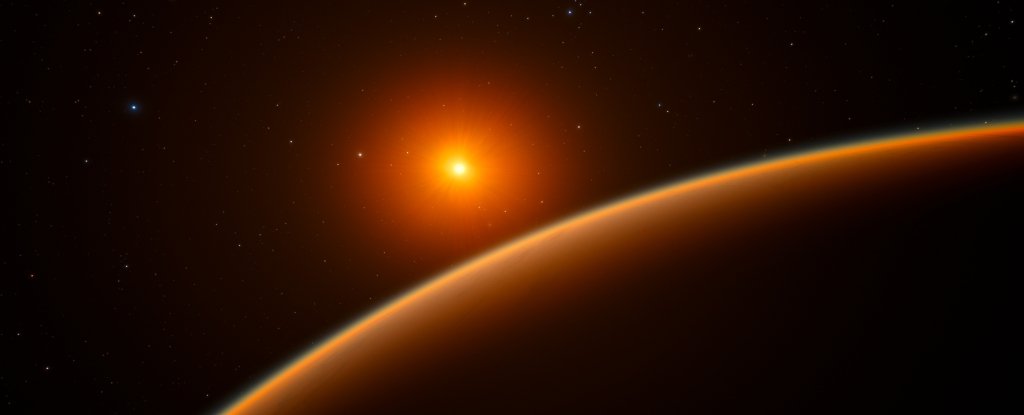
There may be multitudes of Earth-like planets sprinkled throughout the Milky Way galaxy, but they are not so easy to find. To date, only around a third of the over 4,000 exoplanets found and confirmed are rocky - and most of those are within a few thousand light-years of Earth.
So the announcement of a new rocky exoplanet is always exciting - but this particular newly discovered rocky exoplanet is even more exciting yet.
It belongs to the much smaller subset of rocky exoplanets that orbit at an Earth-like distance from its star. And it's a whopping 24,722.65 light-years away from us - which could make it the most distant Milky Way exoplanet discovered yet.
It's so distant, it's close to - and might even be in - the galactic bulge, the densely populated region in the centre of the galaxy.
Although we are getting better and better at finding them, exoplanets are tricky little beasts. They don't give off any light of their own, and any starlight they might reflect would be a tiny, tiny signal lost in the noise of their host star.
Most of the exoplanets we know of have been detected using one of two methods. There's the transit method, which detects planets based in the regular, minuscule dips in starlight when an exoplanet passes in front of it; and there's the wobble method, which detects minuscule wobbling exerted on a star by the gravitational influence of an exoplanet.
But there's a third method, based on the predictions of general relativity: gravitational microlensing. Imagine two stars, one behind the other, and an observer (us) at some distance again. Rays of light from the rear star (the source) are slightly bent by the gravity of the closer star (the lens) as they pass by. This distorts and magnifies that source light - hence, gravitational microlens.
We know what this looks like with two stars - there are so many out there that gravitational microlenses are not uncommon. Thus, when an exoplanet is thrown into the mix, it creates a further disturbance in the light that reaches the observer; we can recognise that as the signature of a planet.
Astronomers can then analyse the light curve of the microlensing event to determine the parameters of the system.
"To have an idea of the rarity of the detection, the time it took to observe the magnification due to the host star was approximately five days, while the planet was detected only during a small five-hour distortion," explained astronomer Antonio Herrera Martin of the University of Canterbury in New Zealand.
"After confirming this was indeed caused by another 'body' different from the star, and not an instrumental error, we proceeded to obtain the characteristics of the star-planet system."
The microlensing event - called OGLE-2018-BLG-0677 - was independently observed by two different experiments, the Optical Gravitational Lensing Experiment (OGLE) Early Warning System and the Korea Microlensing Telescope Network (KMTNet). These experiments generally detect around 3,000 microlensing events a year, most of which are just stars.
"Dr Herrera Martin first noticed that there was an unusual shape to the light output from this event, and undertook months of computational analysis that resulted in the conclusion that this event was due to a star with a low-mass planet," said astronomer Michael Albrow of the University of Canterbury.
Both datasets contributed to the team's analysis.
They determined that the exoplanet is a super-Earth, clocking in at around 3.96 times the mass of Earth. This makes it one of the lowest-mass planets ever discovered using gravitational microlensing.
The star it orbits is really small, just 0.12 times the mass of the Sun - so petite that the researchers couldn't determine whether it was a low-mass star or a brown dwarf. And the orbital distance between the planet and the star is between 0.63 and 0.72 astronomical units - around the distance of Venus from the Sun. But because the star is so small, the planet moves around it pretty slowly - its year is around 617 days.
We won't know if the exoplanet could be habitable any time soon. For one, we don't know the nature of the star. The temperature and activity level of a host star play a big role in habitability, as we define it. And the star is so far away we aren't even close to instruments sensitive enough to study its spectrum, to determine if it has an atmosphere.
But one of the biggest questions about life in the Universe is how often it has the opportunity to arise. We know it can arise on rocky exoplanets, since it did so here on Earth. So the more rocky exoplanets we find, the better we can understand that constraint.
What this research does demonstrate is the extraordinary power of gravitational microlensing as a tool to find those distant, low-mass exoplanets. And it's damn awe-inspiring.






No comments:
Post a Comment